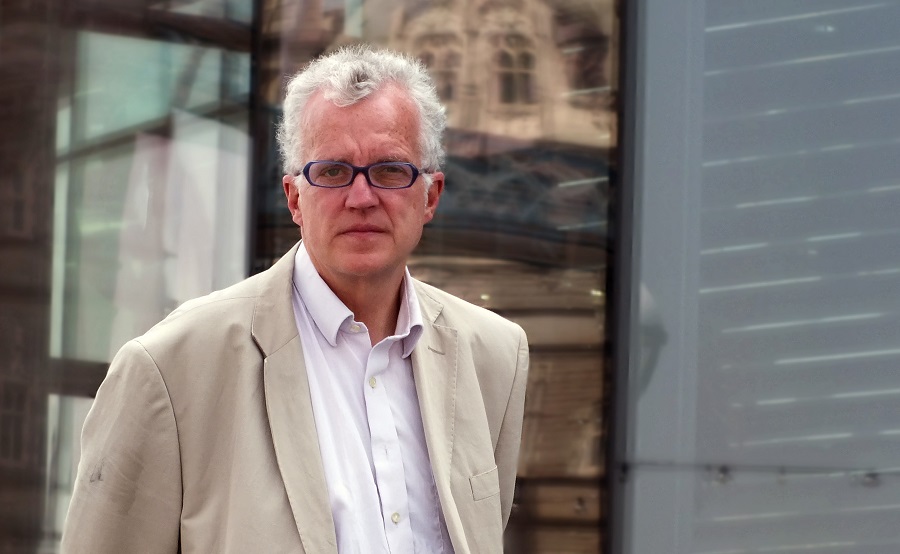Exhibition Road in South Kensington has always been a bit special. It was the first road in Britain to have a tunnel built under it for pedestrians to avoid the traffic above. The tunnel was built by the Metropolitan District Railway in the late 19th century to give people easy access to the burgeoning museums above. Originally the railway charged a penny for the use of the subway but it soon dispensed with the fare and the tunnel has been heavily used ever since while above Exhibition Road has been an unattractive car dominated dual carriageway.v
Now that is set to change as Exhibiton Road is again becoming a pioneer scheme is completed next year. Kensington & Chelsea is turning the street into a ‘shared space’ environment with traffic being reduced to one lane in each direction, and for most of its length discouraged from entering the road at all. There will be no kerbs and the pavements will be extended. The crossing at the busy Cromwell Road will be far easier to negotiate, with a straight through path rather pedestrians being forced to enter a pen in the middle of the road.
It is a new concept for the UK and on a recent visit it was clear the scheme is not being implemented on the cheap. The granite blocks for the road surface are being imported from China and will give far better service than those used in similar schemes such as on London’s Southbank – where cheap road surfaces started breaking up within months of their installation. They are being laid out in an elegant zig zag pattern that helps create an atmosphere of calm rather than the scurrying of a busy road. The cost for just three quarters of a mile and a related scheme, now completed, to improve pedestrian access to South Kensington station, is a shade under £30m, of which almost half is coming from the Mayor and most of the rest from K&C’s own coffers.Exhibition Road.
Councillor Nick Paget-Brown, Kensington & Chelsea’s cabinet member for environment and transport remains unabashed about the price, seeing the road as a key London landmark: ‘More people visit the museums every year than go to Venice. We are turning Exhibition Road into the most beautiful urban street in Britain.’ It certainly will be more pleasant than the tunnel on a summer’s day, but in the kind of cold sleety weather on the day of my visit, I wondered rather mischievously whether many visitors might stay underground!
However, there is no doubt that the project will attract attention and will create a fantastic streetscape. There is, too, a wider element to this story, and that is about change. After the abolition of the GLC in 1986, Kensington & Chelsea council went to the trouble of ripping up the cycle lanes which had been installed on their main roads by the GLC. Cyclists, according to the then leader, Nicholas Freeman, had no place on London’s roads and therefore the cycle lanes were a waste of space. Now, although the council remains Conservative and will do so forever given its demographics, there is a completely new approach to roads and traffic. The council has been the first in the country to allow cyclists to go the wrong way down one way streets and was also responsible for the pioneering redesign of Kensington High Street in the 1990s which has slowed the traffic down and made it far more accessible and pleasant. Pedestrian barriers were removed – and Transport for London is now following that example –cycle parking was installed in the middle of the street and bus lanes widened to accommodate cyclists, ensuring the whole feel of the road was changed from thoroughfare to shopping street.
The Kensington High Street scheme has been an unequivocal success. As it happens, I was brought up just off the high street, and I remember the terrible toll of accidents and pedestrians being run over which were a regular occurrence on such a busy street where traffic was encouraged, by the lay out, to go through fast. Now accidents have gone down and the experiment has been widely lauded. The courage to press through what was seen as a radical scheme gave the council the courage to proceed with the Exhibition Road plan. It has not been without opposition. The Guide Dogs for the Blind charity threatened to launch a judicial review because it was worried that blind people would stumble into the paths of cars as their dogs would not understand the visual cues. Their fears have been allayed and Exhibition Road is going to become, yet again, something special. As Councillor Paget Brown puts it, ‘the policies of the 1960s which favoured cars above all else are being reversed’. It will take courage for other councils to follow suit, especially in these straitened times, but hopefully Exhibition Road will be the first of many streets to be reclaimed from the tyranny of the car.
